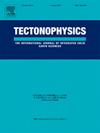Constraining frictional stability-permeability evolution in rock fractures: A comparative study between granite and shale
IF 2.6
3区 地球科学
Q2 GEOCHEMISTRY & GEOPHYSICS
引用次数: 0
Abstract
Large-scale fluid injection during hydraulic fracturing may cause seismic activity during deep geothermal and shale gas development. Constraining the relationship between frictional stability and permeability evolution of fractures is critical since it may provide an indicator to predict frictional behaviors based on monitoring hydraulic evolution. However, the relationship between frictional stability and permeability evolution is poorly understood, especially for different rocks. Hence, we conducted a series of velocity-stepping experiments to explore the shear slip stability of granite and shale fractures, the principal rocks for geothermal and shale gas reservoirs. The results indicate that with the increase of effective normal stress, the permeability and frictional stability (a-b) of both shale and granite fractures decrease. Shale exhibits a velocity-strengthening behavior, while granite exhibits a velocity-weakening behavior when a slip velocity change occurs. By calculating the permeability response parameters (Δk/ktrans), the results show that with the increase of fracture permeability, the possibility of seismicity induced by fluid injection increases, which provides an indicator as an early warning for potentially damaging seismic events. The experimental results of the permeability test also show that the fracture permeability increases slightly after the short slip. In contrast, the long-term slip will inevitably cause a further decrease in the permeability. This study improves our understanding of fracture permeability and slip stability.

岩石裂缝中约束摩擦稳定性-渗透率演化:花岗岩与页岩对比研究
在深层地热和页岩气开发过程中,水力压裂过程中大规模注入流体可能引起地震活动。约束裂缝的摩擦稳定性与渗透率演化之间的关系至关重要,因为它可以为基于水力演化监测的摩擦行为预测提供指标。然而,人们对摩擦稳定性与渗透率演化之间的关系了解甚少,特别是对不同岩石而言。为此,开展了一系列速度步进实验,探讨了地热气藏和页岩气藏的主要储层花岗岩和页岩裂缝的剪切滑移稳定性。结果表明:随着有效正应力的增大,页岩和花岗岩裂缝的渗透率和摩擦稳定性(a-b)均降低;当滑动速度发生变化时,页岩表现出速度增强行为,而花岗岩表现出速度减弱行为。通过渗透率响应参数(Δk/ktrans)的计算,结果表明,随着裂缝渗透率的增加,流体注入诱发地震活动的可能性增加,这为潜在破坏性地震事件的预警提供了指标。渗透率试验结果也表明,短滑后裂缝渗透率略有增加。相反,长期滑移将不可避免地导致渗透率进一步降低。这项研究提高了我们对裂缝渗透率和滑移稳定性的认识。
本文章由计算机程序翻译,如有差异,请以英文原文为准。
求助全文
约1分钟内获得全文
求助全文
来源期刊

Tectonophysics
地学-地球化学与地球物理
CiteScore
4.90
自引率
6.90%
发文量
300
审稿时长
6 months
期刊介绍:
The prime focus of Tectonophysics will be high-impact original research and reviews in the fields of kinematics, structure, composition, and dynamics of the solid arth at all scales. Tectonophysics particularly encourages submission of papers based on the integration of a multitude of geophysical, geological, geochemical, geodynamic, and geotectonic methods
 求助内容:
求助内容: 应助结果提醒方式:
应助结果提醒方式:


